The Samsung Galaxy S6 and S6 edge Review
by Joshua Ho on April 17, 2015 9:00 AM EST- Posted in
- Smartphones
- Samsung
- Mobile
- Galaxy S6
- Galaxy S6 Edge
NAND Performance: The First UFS Phone
Storage performance is often a critical area for user performance, as applications cannot be cached in RAM at every possible moment. Camera performance is also often limited by storage performance as RAM buffers can only do so much to maintain performance before it’s necessary to commit photos to non-volatile storage.
However due to the memory hierarchy to some extent, storage performance is often hard to notice once it’s at a point where things are “good enough”. Unfortunately, in some cases we can see OEMs failing to include sufficiently performant solid-state storage, which can be a major pain point in the user experience when random read/write performance is low enough that there are noticeable IO pauses as the system has to wait for data to be loaded from storage.
The Samsung Galaxy S6 family is the first shipping implementation of UFS (Universal Flash Storage) 2.0 standard, which makes the internal storage model less like an SD card in nature. When comparing the eMMC 5.1 standard to the UFS 2.0 standard, we see a move from a the 400 MB/s maximum of the eMMC 5.1 standard with HS400 physical link interface to MIPI M-PHY, which allows for a theoretical maximum of around 720 MB/s and should be more efficient in transmitting data than the current eMMC standard. In addition, UFS makes it possible to do full duplex communication, which means that reads and writes can happen simultaneously. There's also a command queue, which helps to avoid inefficiencies that could arise from waiting for commands once a command has been processed by the storage controller, and utilizes the SCSI protocol to facilitate these new features at the interface level.
As for the Galaxy S6 itself, the UFS implementation Samsung is using is Samsung developed. Samsung's current implementation only supports up to 300 MB/s (or 2.4 Gbps) transfer rates as a theoretical maximum, so from an interface perspective it's still not reaching the full capabilities of the standard. Though even at a cap of 300MB/sec, it still stands to be a significant improvement over typical eMMC solutions.
Finally, on a technical note, the 32GB models are of the model KLUBG4G1BD-E0B1 with a maximum queue depth of 16.
In order to test storage performance, we use Androbench with some custom settings to get a reasonable idea of performance in this area, although this test isn’t an exhaustive examination of storage performance by any means.
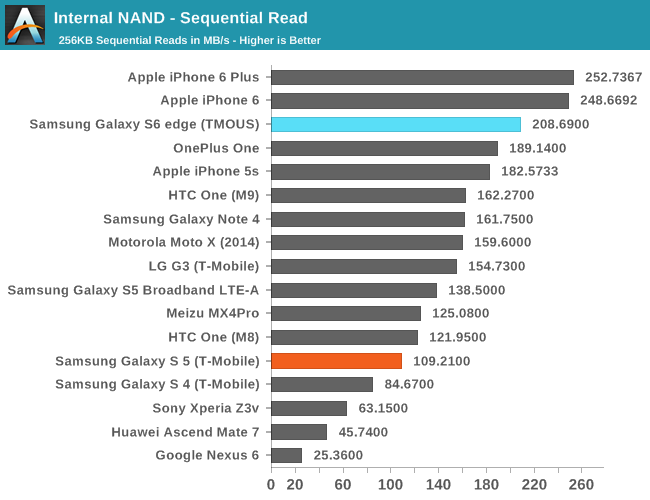
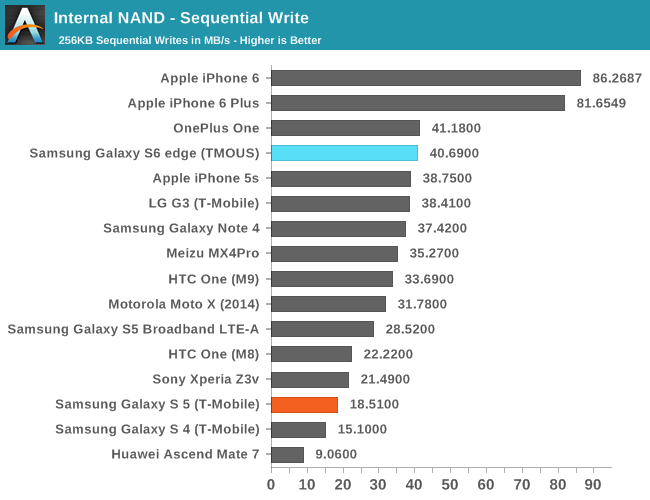
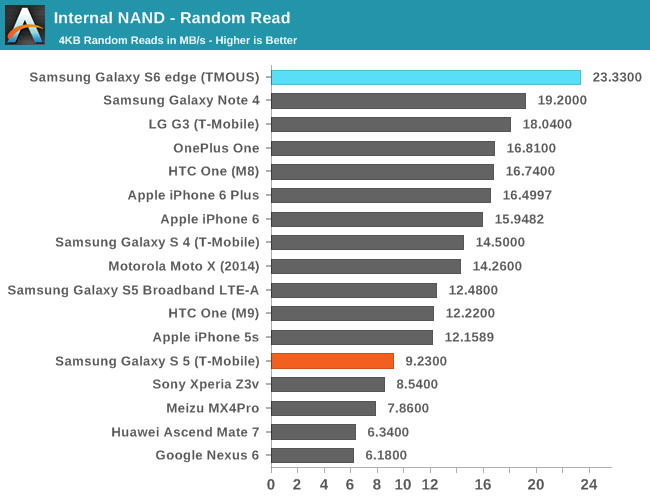
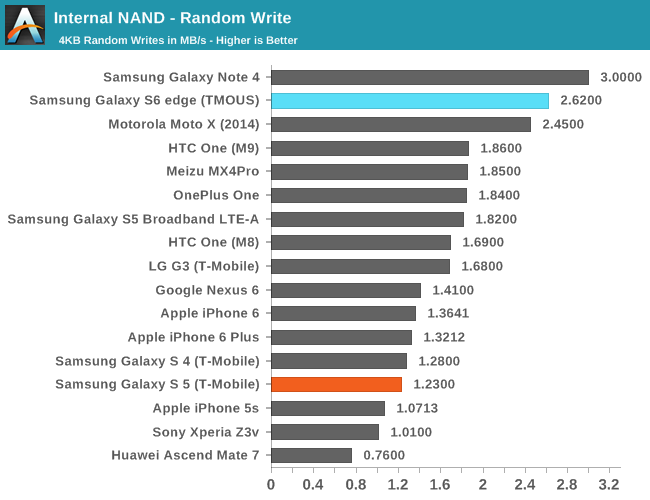
The Galaxy S6 performs rather impressively in our standard storage test, but not as fast as one might have hoped. This is due to the nature of the Androbench 3.6 test, which only tests a single IO thread, which won’t use the UFS storage of the Galaxy S6 to its full extent. In order to see the kind of difference that UFS really makes, I ran the same test again on Androbench 4.x, which does support multiple IO threads. However, as our iOS storage test and Androbench 3.6 don’t support more than a single IO thread we will continue to present both results for now.
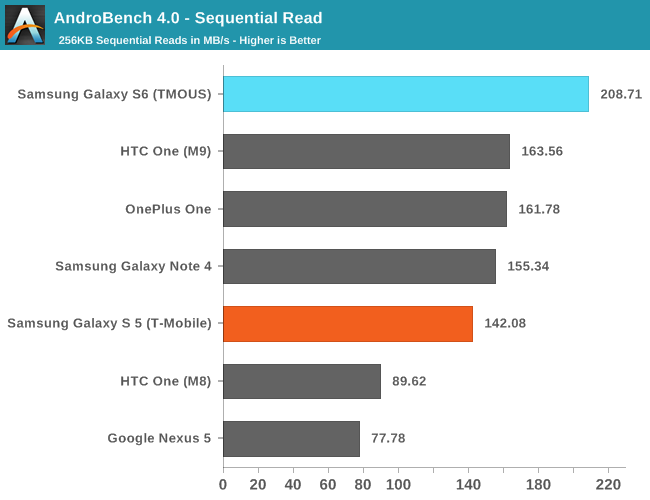
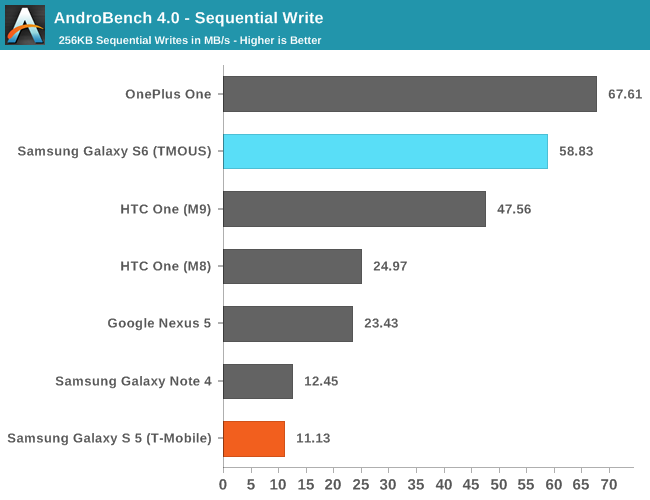
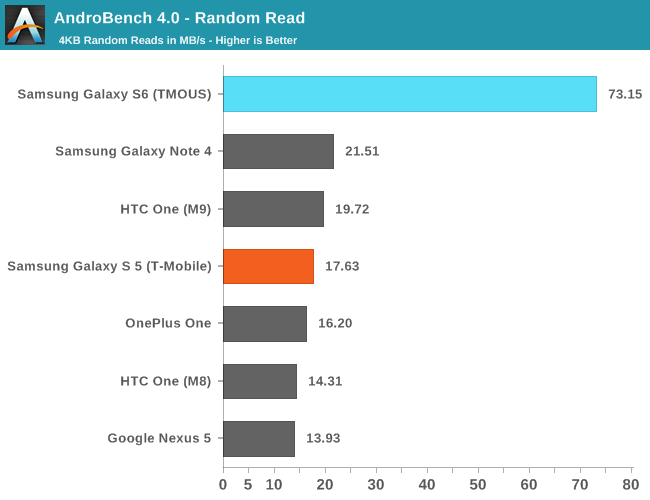
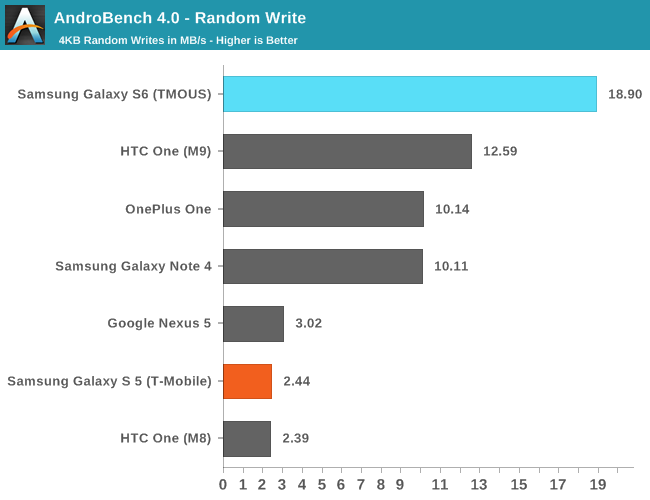
Overall, there are some immense benefits in storage performance here, especially in random IO performance. The Galaxy S6 has some of the fastest storage available in a phone today as far as I can tell given that this is basically a pure MLC solution, and shouldn’t have any real issue with storage performance holding back the rest of the phone over the course of 1-3 years as long as a reasonable amount of free space is kept to allow efficient storage management.


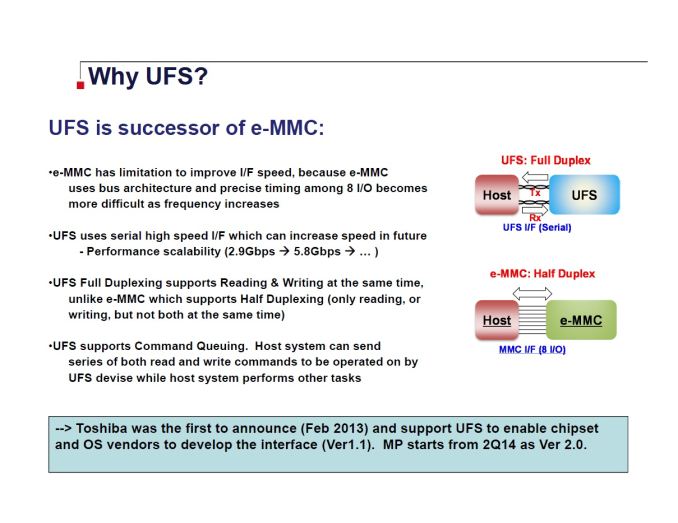








306 Comments
View All Comments
Andrei Frumusanu - Friday, April 17, 2015 - link
Math is hard, corrected, thank you.Arbie - Friday, April 17, 2015 - link
SD Police here: no microSD, no sale. The reasons have been hashed over endlessly but I know what I want.mayankleoboy1 - Friday, April 17, 2015 - link
Im very puzzled by the large differences between the stock browser and Chrome. They both are based on the Blink engine, and use V8 for JavaScript execution.This definitely points to "optimizations" done in the stock browser for these benchmarks.
Could you do some other benchmarks on the phones?
JoshHo - Friday, April 17, 2015 - link
Basemark OS II and PCMark use the internal WebView engine and the 7420 doesn't do nearly as poorly in those browsing benchmarks as it does on Chrome.It's likely that Samsung Mobile has some work to do when it comes to optimizing against Chrome.
lilmoe - Saturday, April 18, 2015 - link
Or, it's the other way around. Google needs to do a LOT of work of optimizing Chrome for the various hardware out there, especially the most popular ones.Chrome isn't getting the highest marks in optimization you know, especially on the desktop. I thought that was a well known and understood issue?
Bob-o - Saturday, April 18, 2015 - link
Can someone explain to me why an application needs to be optimized for certain hardware? Isn't it just using libraries for rendering (OGL, whatever), and those libs have already been optimized for the GPU? And the non-rendering part of the app should be byte-compiled appropriately?Back in the 1980's I used to optimize apps for certain hardware. . . in assembly code. What are they doing these days? And why is it necessary? Poor abstractions?
mayankleoboy1 - Sunday, April 19, 2015 - link
These optimizations are not for specific hardware, but for the specific BENCHMARK. They can easily tweak parameters inside the Javascript engine to give higher score on specific benchmarks like Octane and Kraken. These optimizations would negatively affect the common web JS workloads, but would give higher benchmark score.Google/Mozilla wouldnt do such shenanigans as they do not priortize for specific benchmark, unless it also improves general JS workloads
bji - Friday, April 17, 2015 - link
I have a big problem with the way their camera module juts out from the back of the device. I have a Galaxy S5 Active (my first smart phone) and the camera broke within about 2 months of ownership. I believe it's because it juts out and is a focal point of stresses as a result (pressure while in pocket, pressure when laid on a flat surface, etc), and the very weak glass they use to cover the lense is subject to breaking. I've read many comments from others that this happened to them, and it happened to me. Now the camera is useless.I could put a big ugly case on the thing to protect the camera, sure, but that's why I bought the Active - because I didn't want to put a case on my phone.
I see that Samsung continues with this horrid camera module design. I won't be buying another Samsung with this characteristic.
name99 - Friday, April 17, 2015 - link
I suspect Samsung would do well to copy Apple in one more respect --- making cases a big part of the user experience.Something that critics of the iPhone 6 (in particular the "slippery sides" and "too much sacrificed for thinness" don't seem to get is that, IMHO, Apple sees cases as a significant part of the iPhone experience. Which is why they provide their own --- expensive but very nice --- high end cases, and are willing to accept the inevitable leaks we see from case makers in advance of new products.
Once you accept that a case is part of the story
- the thinness makes more sense, because you're going to be adding a few mm via the case
- likewise the camera bulge, while less than ideal, is not such a big issue
- likewise complaints about the fragility of glass backs, etc.
Cases also allow for a dramatic level of customization without Apple having to stock a zillion SKUs. You could even argue that the aWatch band proliferation is Apple having learned from the size of the case market for iPhones and iPads, and arranging things so that they get the bulk of the high-end money that's available in this space.
Every other phone manufacturer is in a much weaker position than Apple because they don't have the massive range of cases available. But they could at least try to improve the situation by providing their own cases --- maybe at least a high end leather model, a low-end plastic model, and an "I'm paranoid I'm going to drop my phone" model. They should also call out the cases during the big press reveal of each phone (like Apple does) and ship some cases along with each review unit (not sure if Apple does this, but they should).
All of which makes the Edge, IMHO, even more of a gimmick (in spite of Samsung claiming they will no longer do gimmicks). You get a much more expensive manufacturing process to provide something whose real functionality could probably be provided with a few colored LEDs, and you dramatically reduce the design space available for cases.
Oh well. Stay tuned for the next Samsung model which (don't tell me, let me guess) will feature as its big new feature a haptic (don't call it Taptic!) engine and which, with any luck, will manage to ship in at least one country before the iPhone 6S, so that Samsung can claim (and have the true believers accept) that this was their plan all along, that they were in no way influenced by Apple's obvious [based on aWatch and MacBook] next big UI element.
akdj - Sunday, April 26, 2015 - link
Hi name99. Wish there was an up vote;). Well said. As an owner of the iPhone 6+ (& each iteration before it), I've 'finally' found the Apple iPhone case:). Lol. I bought some Platinum Incipio Pro kickstand crap, a really lame Spec case (& I love their laptop shells on my MBP) before I finally made a trip down to the Apple Store and picked up the simple, brown leather iPhone 'Apple' case (I don't remember it being expensive though, seems like 39, maybe 49 bucks? Seems like the standard pricing regardless of manufacturer out of the gate).I'm embarrassed to say since 2007, I've never had the Apple case. Always bought third party and typically Mophies starting with the iPhone 4/4s.
Sorry, TL/dr -- not in defense of Android OEM lack of third party peripherals as its true but this last year, 18 months has changed some. The S-View case specific to the 's' and 'note' brands are pretty sweet. I use one on my Note 4 and like the Apple cam/case combo the S-Case also protects the camera protrusion while adding even more functionality. It's magnet sensing for turn on/off by open/close and the small maybe 2" x 2" 'S-View' (small window on front) allows answering of calls, quick text/tweet/FB/email/whatever-u-set-up response capability, notifications and time (customize faces and information on clock), weather and 'maps', settings, and more. It's slick and it's protective.
But you're right. The Apple iOS cases kick ass. I own the 'smart' cases (not covers, they suck) on our iPads too. Be nice if they quit changing the dimensions ever so slightly each iteration ala iPhone. Usually get two generations of the iPhone outta one case. Single on an iPad. Oh well. Keep em longer too I suppose).
Good to see another avid iOS user. I love both and have since the original 4GB, non subsidized $500 2G iPhone and the Xoom/S1 ...and to date I'm undecided. Don't play with the new Amdroids. They're very nice as well. It's too dangerous now with AT&T/Verizon, even Best Buy, etc. just pick what you want. The color. The capacity. No money down and NEXT fools ya. Before you know it, you've got iPads for everyone in the family. A pair of Nexus 7s you're trying to figure out what to do with, iPhones and Notes... Just 'try' the M9, or the G3/(4 coming?) what the heck, can't hurt. Before you know it you've got a dozen devices all accessing your data, exponentially increases bandwidth used on wifi and LTE for updates and the ilk. And a $700 'phone' bill. Lol. Too cool.
Does t matter which way you go, iPhone 5s/6/6+ or S5/Note4/G3/M8 or 9, Note 4 or this bad boy. They're ALL 'computers' in our pocket. Across the board faster and more energy efficient than computers we used last decade. The storage. The connectivity. The processing and RAM, controllers (micro); accelerometer, barometer, proximity and Bluetooth 4.1, wireless AC and 2x2 antenna arrangement ...without... An antenna ( those of us in our forties, probably mid to late thirties remember those, right? ...other than the sweet 'bands' on my 6+;) course hidden by earlier do dissed Apple's iPhone case. iPad cases. They're sweet. Kinda like their trackpads in comparison to EVERY other OEM. They work. All. The. Time. They NEVER don't. WTH can't Windows get an OEM partner to nail the trackpad? Perhaps that's why they decided on 'touch'? :-)